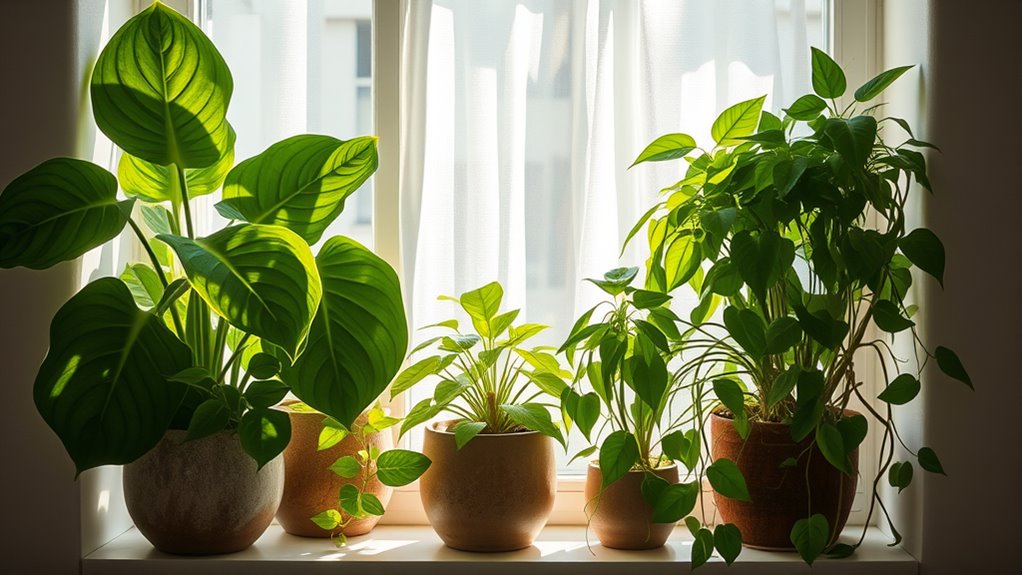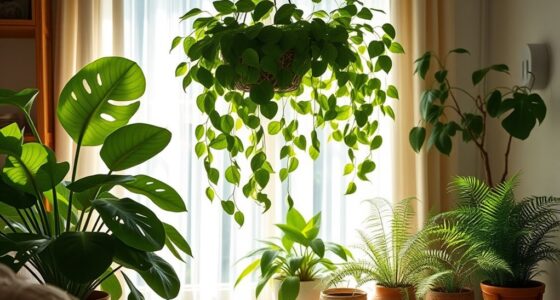Houseplants do more than just look pretty; they actively support your mental health by reducing stress, lowering cortisol levels, and boosting mood. Caring for them encourages mindfulness and provides a calming routine that can ease anxiety and depression. Additionally, plants improve indoor air quality, helping you feel more alert and relaxed. Their natural presence fosters emotional resilience and creativity. Discover how these green companions can truly heal beyond their beauty.
Key Takeaways
- Indoor plants lower cortisol levels, reducing stress and promoting emotional resilience.
- They improve air quality by filtering pollutants, supporting physical health and mental clarity.
- Caring for houseplants fosters mindfulness, which enhances mood and alleviates anxiety and depression.
- The presence of greenery creates calming environments that soothe the mind and reduce psychological stress.
- Indoor plants boost creativity and cognitive performance through visual stimulation and natural ambiance.
The Mental and Emotional Benefits of Indoor Greenery

Indoor greenery offers more than just aesthetic appeal; it actively boosts your mental and emotional well-being. Having plants around can lower cortisol levels, reducing stress and improving your overall mood. Greenery in your home or office has been linked to fewer symptoms of anxiety and depression, providing a calming environment that supports mental health. Caring for houseplants fosters responsibility and mindfulness, which can lift your self-esteem and happiness. The biophilic effects of plants create a sense of tranquility, helping you achieve mental clarity and emotional stability. Engaging with indoor gardening activities also offers therapeutic benefits, easing psychological stress and encouraging relaxation. Additionally, vetted portable camping gear can enhance your outdoor experiences, promoting overall well-being. Incorporating AI technologies into your plant care routine can optimize plant health monitoring, making your gardening experience more effective and enjoyable. Furthermore, understanding the Law of Attraction can help you cultivate a positive environment that attracts health and happiness. Studies in sound design have shown that ambient sounds and natural audio can further enhance your indoor sanctuary, promoting relaxation and mental clarity. Exploring the psychological benefits of nature can deepen your appreciation for the healing power of plants, encouraging you to integrate more greenery into your daily life. Overall, incorporating houseplants into your space promotes a healthier mind and a more positive outlook.
How Houseplants Support Stress Reduction and Relaxation

Houseplants create a calming visual environment that instantly eases your mind. When you touch their leaves or care for them, you activate routines that lower your heart rate and stress levels. Plus, their presence improves air quality, making your space feel more relaxing and healthful. Additionally, studies show that the color accuracy of houseplants’ vibrant greens can positively influence mood and mental well-being. Many stores have retail hours that accommodate plant care visits, enhancing your overall experience. Engaging with houseplants also encourages mindful living, which supports responsible care and nurtures a sense of connection with your environment.
Calming Visual Presence
The presence of lush greenery naturally promotes a sense of calm, helping to lower cortisol levels and reduce stress. Houseplants create a calming visual presence that instantly transforms a space into a peaceful retreat. Their soothing greenery alleviates anxiety and mental fatigue, fostering feelings of well-being. When you focus on caring for your plants, like watering or pruning, you engage in mindfulness, which deepens this sense of tranquility. The natural decor provided by houseplants offers a gentle visual focus that supports mental clarity and emotional stability. By simply incorporating plants into your indoor environment, you invite a serene atmosphere that nurtures relaxation. This calming visual presence connects you to nature, promoting a peaceful mindset and enhancing overall emotional health. Additionally, the act of tending to houseplants can improve air quality, contributing to a healthier and more relaxing living space. Moreover, the presence of houseplants can help reduce indoor pollutants, further supporting your physical and mental well-being. Studies show that biophilic design elements like plants can significantly boost mood and productivity.
Touch and Nurture Benefits
Touching and caring for your houseplants can considerably reduce stress, as these activities lower cortisol levels and promote relaxation. When you touch and nurture your plants, you engage in mindful actions that calm the mind and ease anxiety. Activities like watering, pruning, or simply holding a leaf stimulate a sense of purpose and emotional well-being. This physical connection creates a soothing environment that supports mental clarity and helps you unwind. Regular interaction with greenery in your space not only fosters a nurturing routine but also decreases heart rate and blood pressure, enhancing overall relaxation. By nurturing your houseplants, you actively support your mental health, making these living companions essential for stress relief and emotional resilience. Additionally, engaging in mindfulness during plant care enhances the calming effects, promoting deeper mental and emotional balance. Cultivating a routine of intentional attention to your plants can deepen your connection and amplify these benefits.
Air Quality Enhancement
As you incorporate houseplants into your living space, they actively work to improve air quality by reducing airborne pollutants like formaldehyde and benzene. These plants help filter Volatile Organic Compounds (VOCs), which can cause headaches, respiratory issues, and stress. By lowering indoor air pollutants, houseplants support better indoor air quality and create a more calming environment. They also decrease indoor CO₂ levels, boosting concentration and reducing fatigue, which further promotes relaxation. Properly maintained plants contribute to a soothing atmosphere that can lower cortisol levels. Combining houseplants with good ventilation strategies maximizes air purification, helping you feel clearer and more relaxed. Overall, houseplants are natural allies in fostering a healthier, stress-reducing indoor environment.
The Role of Plants in Improving Indoor Air Quality and Mental Clarity
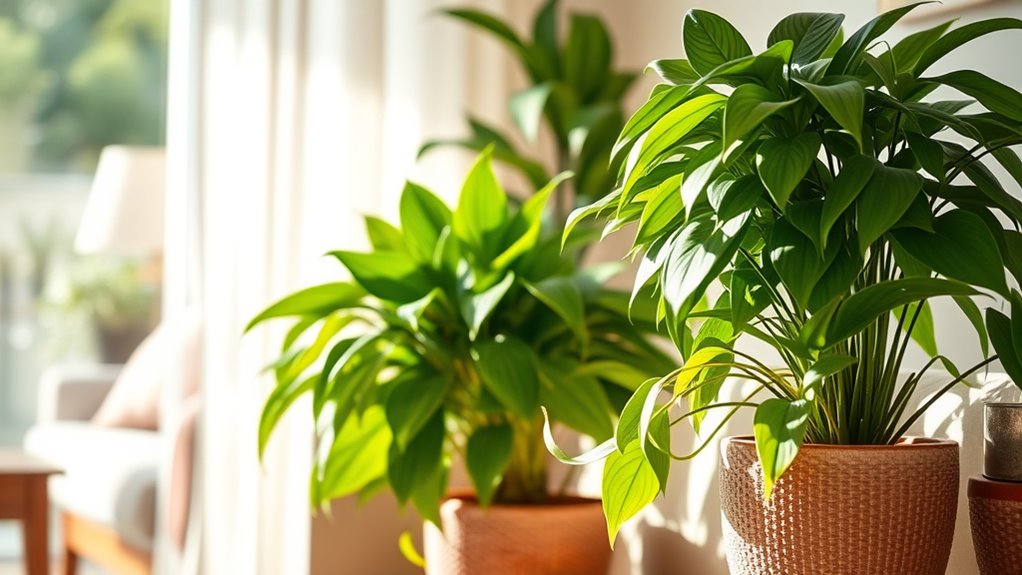
Indoor plants actively improve air quality by absorbing volatile organic compounds like formaldehyde and benzene, which helps reduce indoor air pollution. This not only creates a healthier environment but also offers psychological benefits, such as enhanced mental clarity and reduced fatigue. Proper ventilation combined with strategic plant placement boosts their air-cleaning effects, though plants alone may not eliminate all pollutants. Soil-based systems tend to outperform soil-less media in removing indoor VOCs, supporting better indoor air quality. Keep in mind that the effectiveness varies depending on plant species, environmental conditions, and the size of your plant collection. Additionally, ongoing advancements in machine learning technology are being used to develop smarter air quality monitoring systems that can optimize plant placement for maximum benefits. For example, integrating air quality sensors with plant systems can dynamically adjust conditions to enhance purification. As a result, incorporating houseplants can help you breathe easier and stay more focused throughout your day. Regular maintenance and choosing the right appliance maintenance plans can ensure your air quality improvements are sustained over time. Moreover, selecting aesthetic home decor that complements your plant arrangements can enhance both visual appeal and environment benefits.
Enhancing Mood and Creativity Through Natural Elements
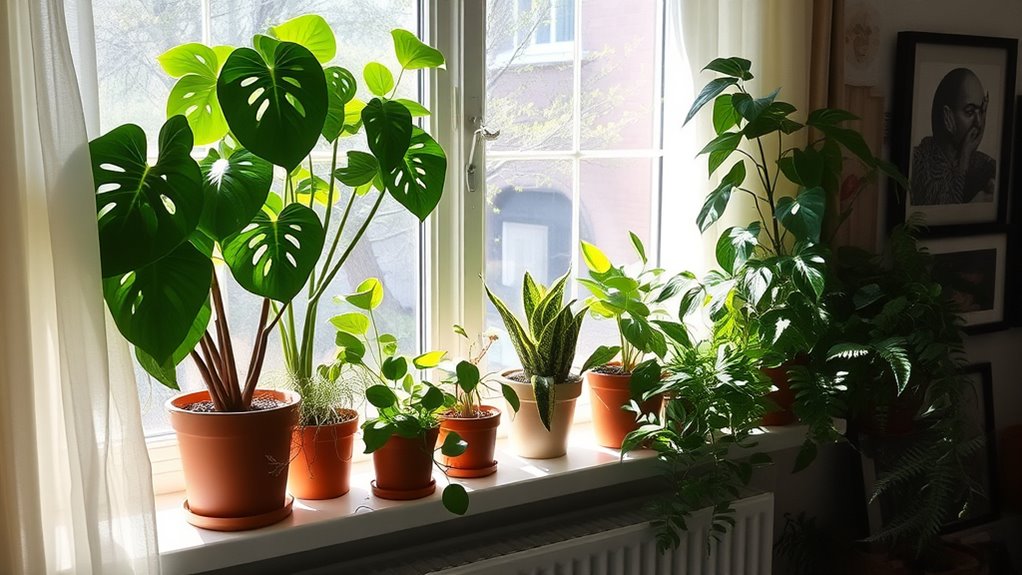
Bringing natural elements like houseplants into your indoor space can notably boost your mood and spark creativity. The presence of greenery creates a calming, natural atmosphere that reduces stress and enhances psychological well-being. When you surround yourself with vibrant plants or those with unique leaf patterns, you foster positive feelings and emotional resilience. Indoor plants also serve as visual stimuli, inspiring fresh ideas and improving problem-solving skills. Incorporating natural elements into workspaces or learning environments increases motivation and strengthens cognitive performance. Regular interaction with your houseplants promotes mindfulness and emotional satisfaction, further supporting your mental health. Additionally, integrating natural elements into environments can promote overall well-being and mental health benefits. Creating a connection with nature indoors has been shown to boost mental clarity, which can lead to increased productivity. Studies also suggest that houseplants can improve air quality, adding another layer of health benefits. Moreover, choosing the right planters and containers can enhance the growth and aesthetic appeal of your indoor garden. Overall, adding plants to your environment isn’t just decorative—it’s a simple yet powerful way to elevate your psychological state and open your creative potential.
The Therapeutic Impact of Caring for Houseplants
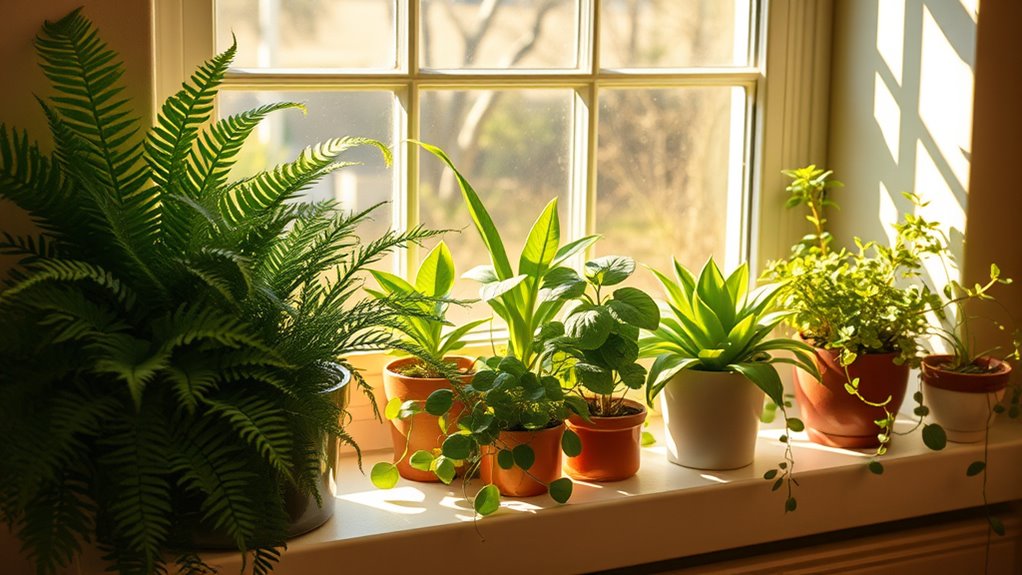
Caring for houseplants offers more than aesthetic enjoyment; it provides a therapeutic activity that can substantially improve your mental health. When you water, prune, and tend to your houseplants, you engage in mindfulness, which reduces stress and lowers cortisol levels. This nurturing process fosters feelings of achievement and emotional stability, helping to lift your mood. Indoor gardening acts as horticultural therapy, easing symptoms of depression and anxiety through therapeutic interaction with greenery. Regular contact with houseplants enhances your sense of happiness and emotional resilience. The calming act of nurturing plants also improves focus, patience, and emotional well-being. By caring for your houseplants, you create a calming routine that nurtures both your plants and your mental health.
Indoor Plants and Their Effect on Anxiety and Depression
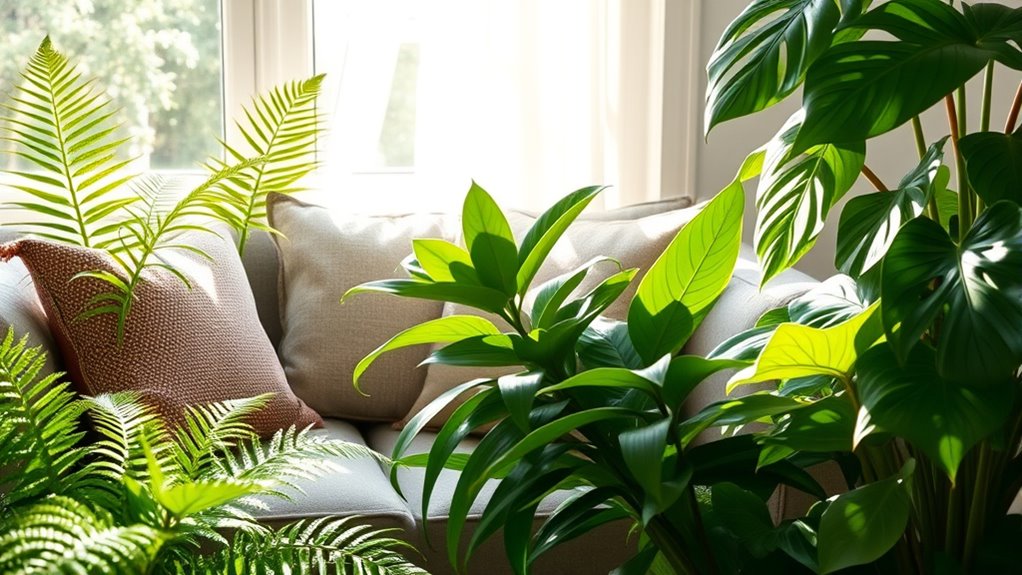
Indoor plants can help lower your stress levels by reducing cortisol, making you feel calmer and more centered. Taking care of them also encourages mindfulness, which boosts your mood and emotional resilience. Overall, the presence of greenery indoors creates a soothing environment that supports mental well-being.
Stress Reduction Benefits
Houseplants can considerably reduce stress and improve mental well-being by creating calming environments that promote relaxation. They help lower cortisol levels, a hormone linked to stress, which reduces anxiety and fosters a sense of calm. Engaging in routine plant care, like watering and pruning, offers therapeutic benefits, serving as mindfulness practices that help ease symptoms of depression and anxiety. The presence of indoor greenery creates a soothing atmosphere, especially during stressful times, enhancing emotional stability. Studies show that indoor plants decrease psychological stress responses and boost feelings of well-being. Incorporating houseplants into your living or workspace can also reduce fatigue, increase comfort, and strengthen your connection to nature—all essential components for supporting your mental health and stress reduction.
Mood Enhancement Effects
Have you ever noticed how a touch of greenery can lift your spirits? Indoor plants help boost your mood and reduce stress by lowering cortisol levels. Caring for your plants through watering or pruning encourages mindfulness, which can ease depression symptoms. The calming presence of greenery creates a peaceful environment, decreasing anxiety and fostering emotional well-being. Studies show that exposure to houseplants increases happiness and promotes a positive outlook. Incorporating plants into your space isn’t just aesthetic; it actively supports mental health. The table below highlights some ways plants influence your mood and stress levels:
| Benefit | Effect |
|---|---|
| Mood enhancement | Increases happiness and positivity |
| Stress reduction | Lowers cortisol and anxiety levels |
| Mindfulness | Promotes calming routines |
| Emotional well-being | Supports mental health and resilience |
| Overall atmosphere | Creates a peaceful environment |
Choosing the Right Plants for Maximum Healing Benefits
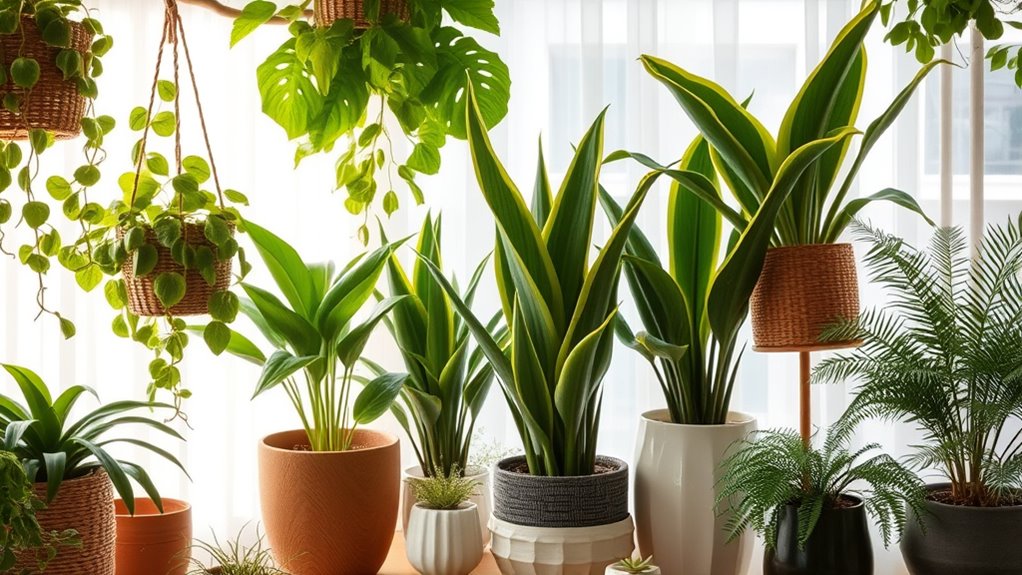
Choosing the right plants can considerably boost their healing benefits, especially when you select species that are easy to care for and resilient. Opt for foliage plants like spider plants, snake plants, or pothos that tolerate low light and fluctuating temperatures, ensuring consistent health benefits. Incorporate a variety of plants to improve air purification, as multiple species target different VOCs such as formaldehyde, benzene, and trichloroethylene. Using soil-based systems or larger plant media can enhance VOC removal compared to smaller containers. Be mindful of safety by avoiding toxic plants if you have children or pets, and consult reputable lists for safe options. Selecting plants with broad, lush leaves and vibrant greenery maximizes psychological benefits, helping you reduce stress and promote overall well-being.
Understanding the Limitations and Ongoing Research on Plant-Based Healing
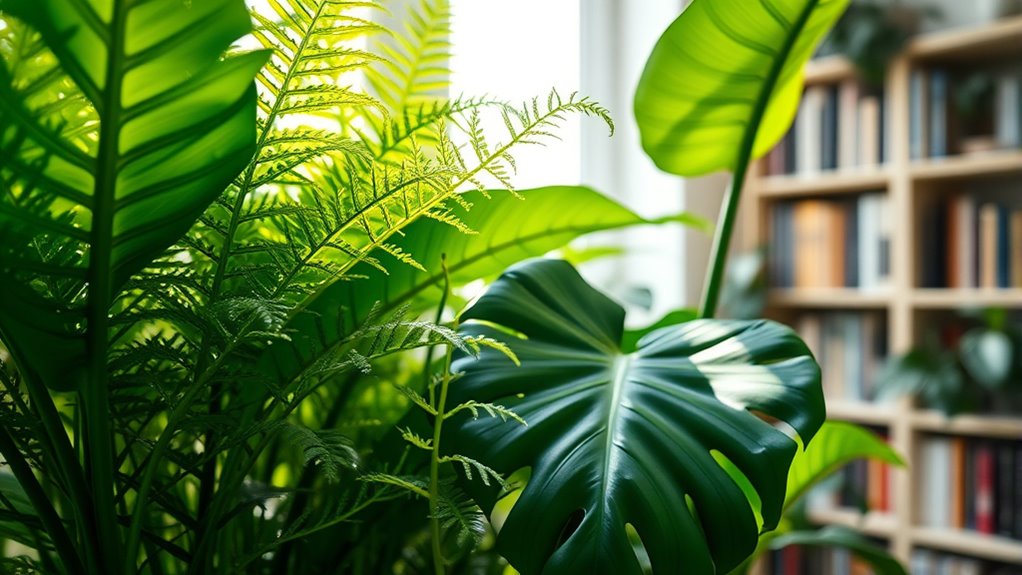
While selecting resilient plants can enhance their healing potential, it’s important to recognize that research into their actual benefits remains complex and sometimes inconsistent. Studies on indoor plants’ ability to improve air quality show mixed results, often affected by environmental factors like temperature, light, and air exchange. The psychological benefits of indoor plants, such as reduced stress and improved mood, are more reliably observed, but their impact on air purification is limited when plants are used alone. In fact, achieving significant air quality improvements requires more plants than typical homes or offices can support. Ongoing research continues to explore how plant media, placement, and environmental conditions influence these benefits, highlighting that indoor plants are valuable but not a standalone solution for healing.
Frequently Asked Questions
Why Is Gen Z Obsessed With Plants?
You’re drawn to plants because they offer more than just visual appeal; they help you feel better mentally and physically. Caring for houseplants reduces stress and boosts your mood, fitting perfectly with your eco-conscious lifestyle. Social media fuels your passion by showcasing beautiful plant setups and tips. Plus, low-maintenance options like succulents make plant care easy and rewarding, helping you connect with nature even in small urban spaces.
Is It Healthy to Have a Lot of Houseplants?
They say “less is more,” and when it comes to houseplants, this holds true. Having many can boost your mood and improve air quality, but overdoing it risks mold, pests, and plant health issues. To stay healthy, keep a balanced number of plants, give them proper care, and make certain your space doesn’t become overcrowded. This way, you enjoy their benefits without compromising your well-being.
What Is the Most Healing House Plant?
If you’re wondering about the most healing houseplant, the snake plant stands out. It actively purifies your indoor air by removing toxins like formaldehyde, benzene, and xylene. It’s easy to care for, tolerates low light, and even produces oxygen at night, supporting your breathing and sleep quality. Incorporating a snake plant into your space can boost your mental and physical well-being effortlessly.
Why Do Millennials Love Houseplants?
You love houseplants because they’re more than just pretty decorations; they boost your mental health, reduce stress, and improve your mood. With limited outdoor space, indoor plants help you stay connected to nature and promote self-care. They also enhance your home’s air quality and foster a sense of community through online plant care groups. Ultimately, houseplants support your well-being and make your space feel more vibrant and calming.
Conclusion
As you explore the healing power of houseplants, you’ll discover they’re more than just decor—they’re potential sources of real well-being. But what if the true magic lies in how they transform your space and mindset? The benefits are profound, yet some mysteries remain. Are you ready to uncover their full potential and see how a simple plant could change your life in unexpected ways? The next chapter of your green journey awaits—are you ready to take the leap?
